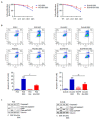Adipocyte-Derived Extracellular Vesicles Promote Prostate Cancer Cell Aggressiveness by Enabling Multiple Phenotypic and Metabolic Changes
- PMID: 35954232
- PMCID: PMC9368412
- DOI: 10.3390/cells11152388
Adipocyte-Derived Extracellular Vesicles Promote Prostate Cancer Cell Aggressiveness by Enabling Multiple Phenotypic and Metabolic Changes
Abstract
Background: In recent decades, obesity has widely emerged as an important risk factor for prostate cancer (PCa). Adipose tissue and PCa cells have been shown to orchestrate a complex interaction network to support tumor growth and evolution; nonetheless, the study of this communication has only been focused on soluble factors, although increasing evidence highlights the key role of extracellular vesicles (EVs) in the modulation of tumor progression.
Methods and results: In the present study, we found that EVs derived from 3T3-L1 adipocytes could affect PC3 and DU145 PCa cell traits, inducing increased proliferation, migration and invasion. Furthermore, conditioning of both PCa cell lines with adipocyte-released EVs resulted in lower sensitivity to docetaxel, with reduced phosphatidylserine externalization and decreased caspase 3 and PARP cleavage. In particular, these alterations were paralleled by an Akt/HIF-1α axis-related Warburg effect, characterized by enhanced glucose consumption, lactate release and ATP production.
Conclusions: Collectively, these findings demonstrate that EV-mediated crosstalk exists between adipocytes and PCa, driving tumor aggressiveness.
Keywords: Warburg effect; adipocytes; chemoresistance; extracellular vesicles; metastasis; obesity; prostate cancer.
Conflict of interest statement
The authors declare no conflict of interest.
Figures





Similar articles
-
Lung cancer-derived extracellular vesicles induced myotube atrophy and adipocyte lipolysis via the extracellular IL-6-mediated STAT3 pathway.Biochim Biophys Acta Mol Cell Biol Lipids. 2019 Aug;1864(8):1091-1102. doi: 10.1016/j.bbalip.2019.04.006. Epub 2019 Apr 17. Biochim Biophys Acta Mol Cell Biol Lipids. 2019. PMID: 31002945
-
Circulating adipocyte-derived extracellular vesicles are novel markers of metabolic stress.J Mol Med (Berl). 2016 Nov;94(11):1241-1253. doi: 10.1007/s00109-016-1446-8. Epub 2016 Jul 9. J Mol Med (Berl). 2016. PMID: 27394413 Free PMC article.
-
Adipocytes reprogram prostate cancer stem cell machinery.J Cell Commun Signal. 2023 Sep;17(3):915-924. doi: 10.1007/s12079-023-00738-x. Epub 2023 Mar 20. J Cell Commun Signal. 2023. PMID: 36940071 Free PMC article.
-
Intercellular and interorgan crosstalk through adipocyte extracellular vesicles.Rev Endocr Metab Disord. 2022 Feb;23(1):61-69. doi: 10.1007/s11154-020-09625-x. Epub 2021 Jan 14. Rev Endocr Metab Disord. 2022. PMID: 33447986 Review.
-
Beyond the Extracellular Vesicles: Technical Hurdles, Achieved Goals and Current Challenges When Working on Adipose Cells.Int J Mol Sci. 2021 Mar 25;22(7):3362. doi: 10.3390/ijms22073362. Int J Mol Sci. 2021. PMID: 33805982 Free PMC article. Review.
Cited by
-
The PI3K/Akt Pathway and Glucose Metabolism: A Dangerous Liaison in Cancer.Int J Biol Sci. 2024 May 27;20(8):3113-3125. doi: 10.7150/ijbs.89942. eCollection 2024. Int J Biol Sci. 2024. PMID: 38904014 Free PMC article. Review.
-
Obesity-Related Cross-Talk between Prostate Cancer and Peripheral Fat: Potential Role of Exosomes.Cancers (Basel). 2022 Oct 17;14(20):5077. doi: 10.3390/cancers14205077. Cancers (Basel). 2022. PMID: 36291860 Free PMC article. Review.
-
Update on Adipose Tissue and Cancer.Endocr Rev. 2023 Nov 9;44(6):961-974. doi: 10.1210/endrev/bnad015. Endocr Rev. 2023. PMID: 37260403 Free PMC article.
-
An Overview of Inter-Tissue and Inter-Kingdom Communication Mediated by Extracellular Vesicles in the Regulation of Mammalian Metabolism.Int J Mol Sci. 2023 Jan 20;24(3):2071. doi: 10.3390/ijms24032071. Int J Mol Sci. 2023. PMID: 36768391 Free PMC article. Review.
-
Exosomes That Have Different Cellular Origins Followed by the Impact They Have on Prostate Tumor Development in the Tumor Microenvironment.Cancer Rep (Hoboken). 2024 Sep;7(9):e70001. doi: 10.1002/cnr2.70001. Cancer Rep (Hoboken). 2024. PMID: 39229670 Free PMC article. Review.
References
Publication types
MeSH terms
Supplementary concepts
LinkOut - more resources
Full Text Sources
Medical
Research Materials

